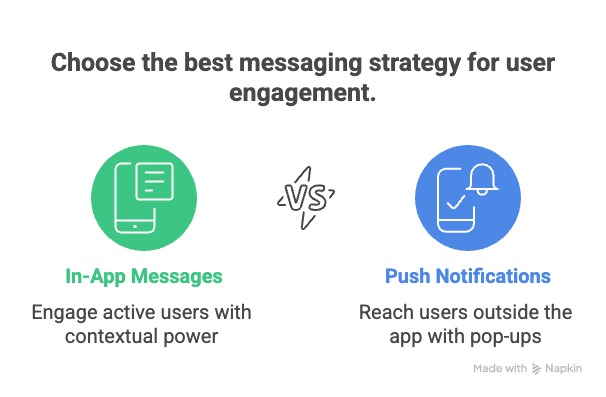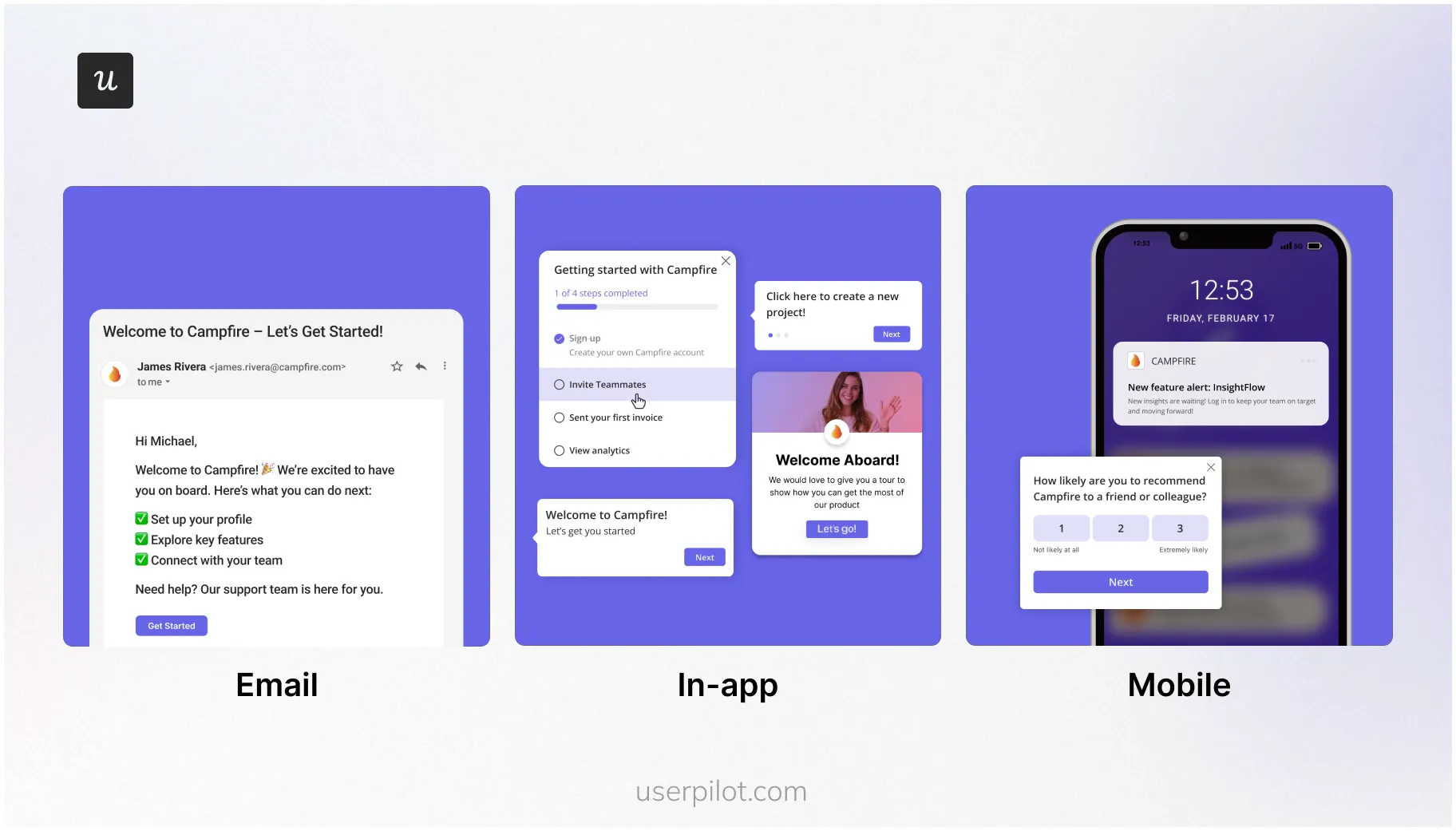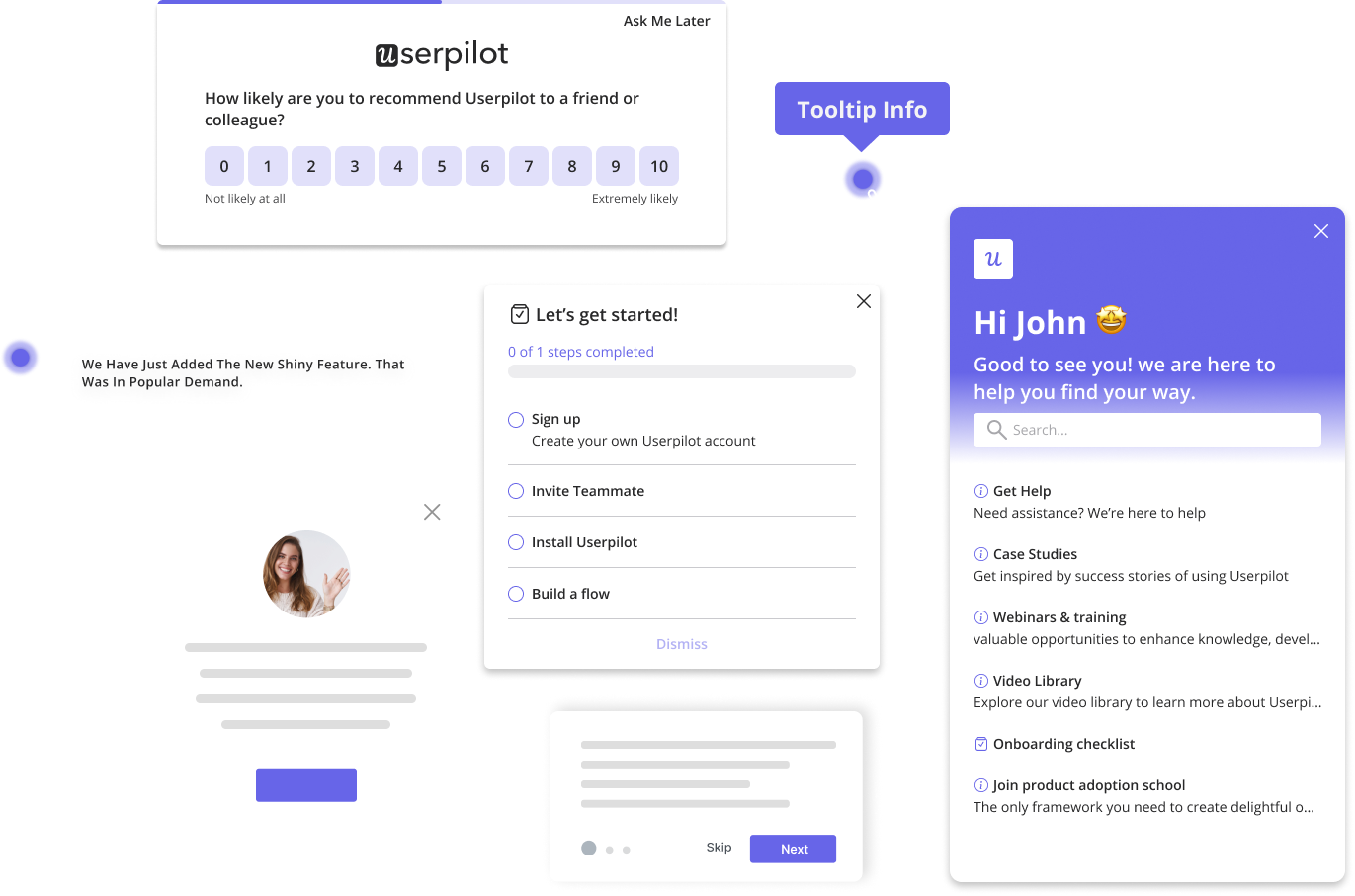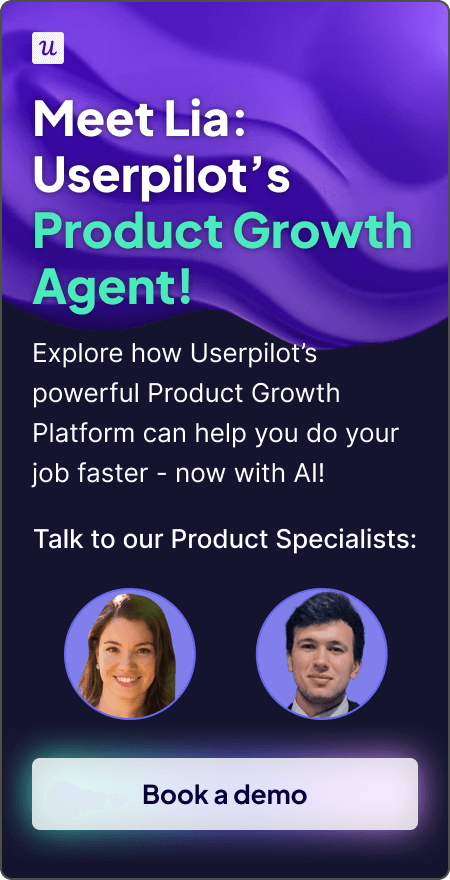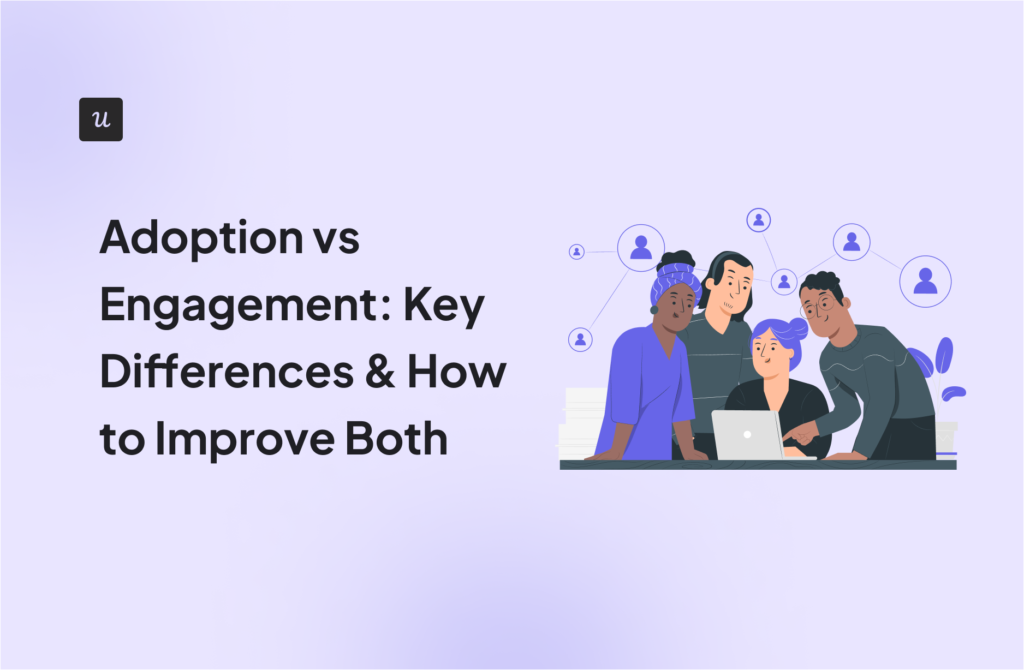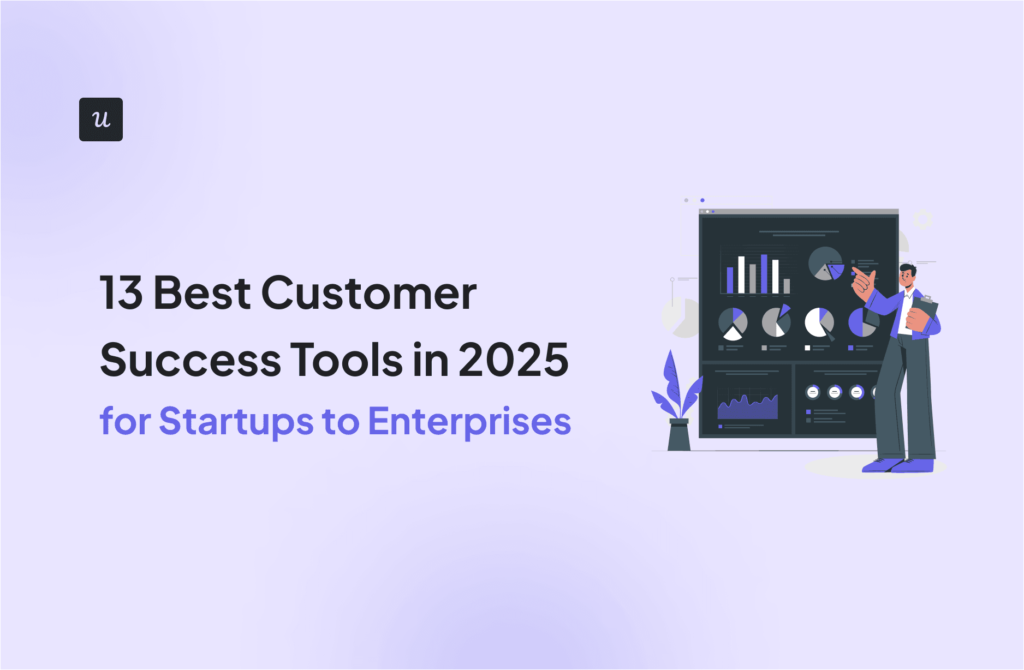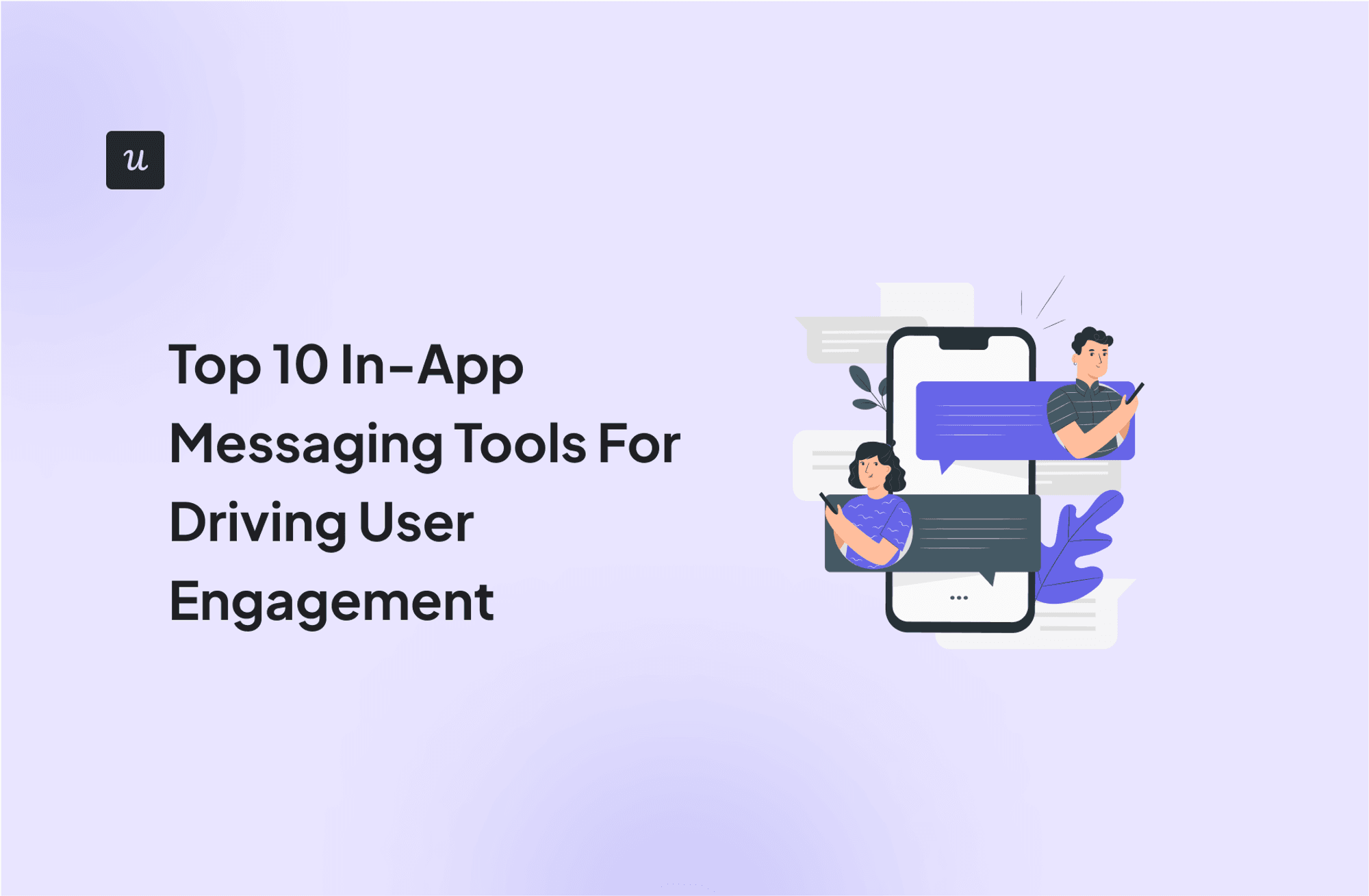
In-app messaging tools are powerful communication channels that improve app retention and enhance brand loyalty.
As smartphones increasingly become central to the routine life of the modern person, in-app messaging enables you to engage your audience with just-in-time support.
This article discusses how in-app messaging works and the tools to grow your product and business, and the top 10 in-app messaging tools:
| Tool | Best For | Description |
|---|---|---|
| Userpilot | Web and Mobile apps | Powerful, no-code platform for product teams to create in-app experiences. |
| UserGuiding | Small businesses | Simple and affordable tool with guided tours and in-app messages. |
| Pendo | Mobile apps | Feature-rich with mobile support, but geared toward enterprise pricing. |
| Firebase | Technical teams | Developer-centric with flexible SDKs for custom in-app messaging. |
| Whatfix | Employee engagement | Great for internal use—ideal for training and onboarding enterprise teams. |
| MoEngage | AI-powered messaging | Predictive analytics and AI for personalized in-app campaigns. |
| Pushwoosh | Omnichannel communication | Unified messaging across in-app, push, email, and more. |
| CometChat | Audio and video in-app messaging | Real-time chat, voice, and video features embedded into web/mobile apps. |
| Leanplum | Strategy optimization | Test, personalize, and automate in-app messages for growth. |
| Intercom | Chatbot-driven messaging | Known for its live chat, automation, and proactive in-app customer support. |
What’s your primary goal with in-app messaging tools?
How important is a no-code builder for your team?
Do you need advanced segmentation and A/B testing to optimize your campaigns?
It looks like you need a powerful, no-code solution to achieve your goals.
Find the right in-app messaging tools to drive user engagement and growth. Userpilot can help you build personalized in-app experiences without writing a single line of code.
Try Userpilot Now
See Why 1,000+ Teams Choose Userpilot
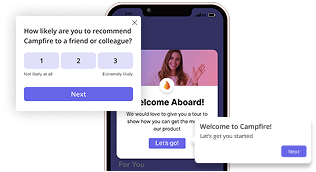
What is in-app messaging?
In-app messaging refers to the different ways you can engage users while they are actively using your app.
The idea is to guide users through their journey by sending relevant messages at the right time.
In-app messages vs push notifications
In-app messages and push notifications are often used interchangeably, but they are quite different.
Users receive in-app messages when they are actively using your app. They can appear in different sizes and are customized for individual users to boost conversion.
Push notifications are messages that users receive when the app is not in use. They appear via pop-ups or banners on their lock screen.
Push notifications are not as powerful as in-app messages because they can easily be buried alongside other notifications before a user even unlocks his/her phone.
On the other hand, an in-app message is usually impossible to ignore as it targets active users and has strong contextual power.
Key features of in-app messaging platforms
Some of the best in-app messaging solutions are built with specific features that help them deliver high-value messages that motivate action.
The key features are:
- No code builder/editor: The best in-app messaging platforms employ a simple drag-and-drop editor for creating and customizing messages so even most non-technical team members can create seamless messages within minutes.
- Rich media support: You can embed rich media such as images, videos, and GIFs in your in-app messages to appeal to and engage users better.
- Advanced segmentation: In-app messaging tools have segmentation capabilities that let you deliver highly personalized messages to different user groups.
- Analytics insights: In-app messaging platforms use real-time analytics to track clicks and impressions and trigger the right messages to active users. They can also analyze how users interact with these, so you can improve your in-app marketing campaigns.
- Experimentation tools for optimizing the conversion rates: Run tests to find the right wording, format, copy, and even timing for your in-app messages. You can test different message templates and variants to identify the best version for your users.
- User feedback collection tools: With these tools, you can collect in-app user feedback to identify user preferences, find opportunities for improvement, and enhance customer satisfaction.
10 Best in-app messaging tools for SaaS companies
Let us now examine some of the best in-app messaging tools on the market and help you determine the perfect one for you.
1. Userpilot: Best in-app messaging solution for web and mobile apps
Userpilot’s in-app messaging capability enables interaction within your web app to onboard new users or encourage feature adoption among existing users.
Key app features
- Different in-app message formats: You can deliver in-app messages in different formats, including modals, tooltips, native tooltips, slideouts, checklists, banners, hotspots, and in-app surveys.
- Omnichannel communication: With Userpilot, you can create different experiences for in-app, mobile, and email communication.
- Contextual triggers. You can set up different types of in-app events (clicks, hovers, or even a combination of those into one) and trigger engagement flows when those events occur. You can even segment users based on their behavior and send highly relevant messages, ensuring a contextual product experience.
- AI writing assistant: With Userpilot’s AI writing assistant, teams can enhance and personalize the in-app messages to boost engagement. With artificial intelligence, you can strengthen the copy of your message and even shorten it to improve overall readability.
- A/B and multivariate testing for in-app messaging campaigns: You can run experiments using different versions of an in-app message to identify the most effective combinations (copy, timing, and presentation) that yield the best conversation rates.
Pricing
Userpilot offers flexible pricing based on your monthly active users (MAUs). Plans start at $299 per month for smaller teams and scale as your user base grows.
Below are the pricing tiers you can choose from:
- The Starter plan begins at $299/month (billed annually) for up to 2,000 monthly active users. It includes in-app user engagement, usage trend analysis, NPS surveys, and essential product analytics—ideal for mid-market SaaS teams getting started.
- The Growth plan offers custom pricing and adds advanced analytics, retroactive event auto-capture, in-app surveys, session replay, and more. It’s the most popular choice for growing teams that need deeper insights and scale.
- The Enterprise plan offers custom pricing and includes everything in Growth, plus bulk data handling, custom roles and permissions, SOC 2 Type 2 compliance, and enterprise-level support.

2. UserGuiding: Best in-app messaging tool for small businesses
UserGuiding is a no-code solution for SaaS startups in need of an easy-to-use tool for a small but growing team.
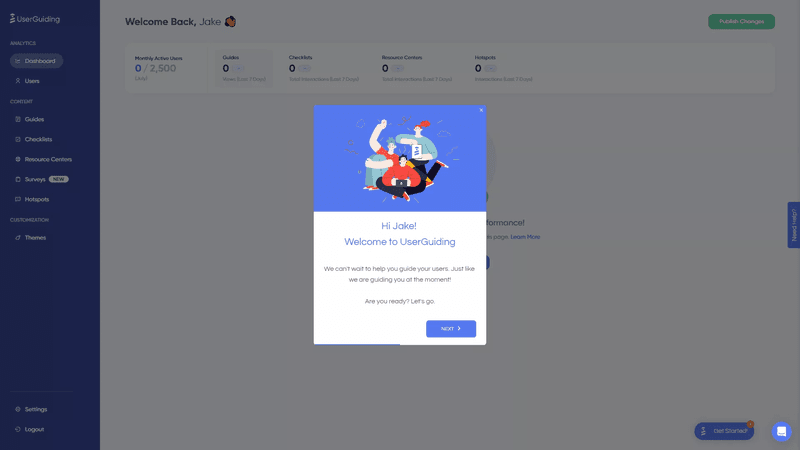
Key features
- Resource centers: UserGuiding’s resource center offers in-app support and self-service to your customers. It is also designed to educate users and help them discover and adopt your product features.
- Chat integrations: You can connect UserGuiding’s chat integrations with your customer support tool stack to give users a seamless app experience.
- Knowledge base integrations: UserGuiding lets you connect the resource center with your knowledge base, allowing users access to support articles in your software.
Pricing
UserGuiding has three pricing tiers, depending on the needs of your business and the number of active users:
-
Support Essentials: free forever – for knowledge base, Resource Center, AI assist, updates.
-
Starter: ~$174/month – limited guides/resource center, basic features.
-
Growth: ~$349/month – full product adoption features, unlimited content, A/B testing.
-
Enterprise: Custom – advanced compliance, security, coaching, multi-container/team support.
3. Pendo: Best in-app messaging platform for mobile apps
Pendo is a powerful in-app messaging platform that offers in-app guides for mobile app users to help them familiarize themselves with your product.
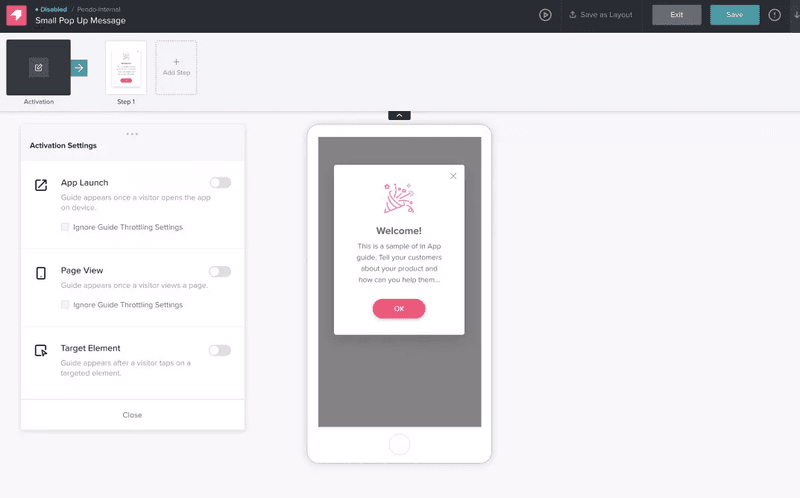
Key features
- Contextual messaging: Pendo lets you segment your users based on usage data and user actions. This way, you can deliver personalized content to target users and user groups.
- Resource center: Pendo’s resource center lets you store documentation for your users. You can play around with the segmentation settings to make certain content visible to specific groups. You can also add product updates, guides, and checklists, and even get feedback from your users right from within the resource center.
- Support tooltips: Pendo’s tooltips allow you to respond to questions before users ask them. It also lets you deflect support tickets, giving your customer support teams more time to manage complex issues.
Pricing
Let’s talk numbers.
Pendo’s pricing is far from budget-friendly. According to data from Vendr, the paid plan starts at $15,900 annually, but real-world costs are much higher. On average, mid-sized teams spend about $47,330 annually, but enterprise customers may pay up to $140,000.
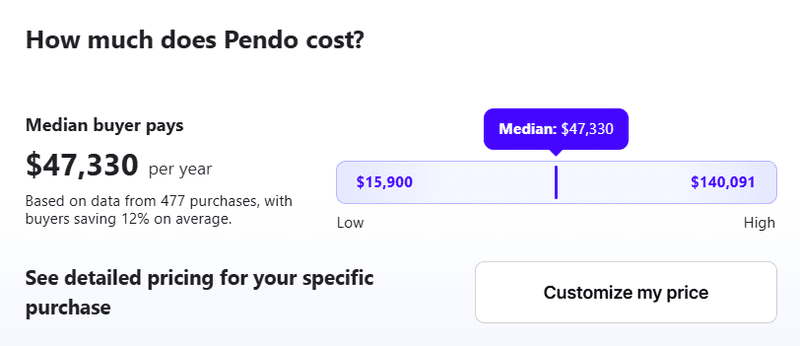
That’s a hefty bill! Especially when competitors like Userpilot offer similar product adoption and analytics features at a fraction of the cost with transparent, upfront pricing.
But the cost isn’t the only concern. Pendo’s pricing model comes with a few key challenges, as expressed by Pendo users:
- High upfront costs. Some startups were quoted $30,000 annually for basic plans or even $85,000+ for more advanced use cases.
- Opaque pricing. Since Pendo doesn’t publicly list detailed pricing, teams typically need to go through sales conversations to receive a custom quote.
- Multi-year contracts for discounts and annual price hikes. Many businesses must commit to multi-year contracts to lock in lower rates at auto-renewal. Those who don’t may see annual price increases ranging from 5-10%, with some cases reported as high as 20%, depending on their agreement.
- Limited integration support on Pendo’s Base tier. Teams that rely on multiple tools may find the single integration in the Base plan restrictive—Core and above unlock additional or unlimited integrations.
4. Firebase: Best platform for technical teams
Firebase in-app messaging is tailored for developers and marketers to target users based on their behavior, engagement, language, and location.
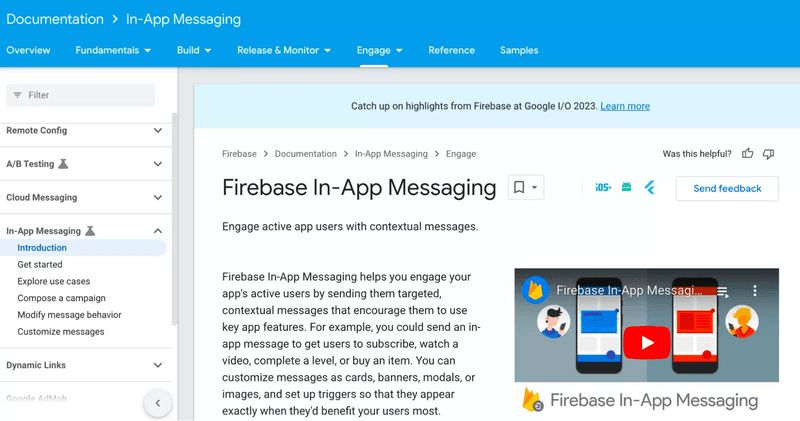
Key features
- Last app engagement: You can assess user activity between one and seven days and send specific messages based on their engagement levels. Based on their activity, you can ask if they are enjoying your app and send a Google Play link for a review if the response is positive. Not a built-in feature; must be custom-built via events + targeting.
- Targeted messaging: Firebase connects Google Analytics with an import segment feature to help you deliver in-app communication to users you want to reach. You can send messages based on a user’s past behavior, demographics, and attributes.
- Custom alerts: You can customize the style, appearance, and content of your message. This way, you can send different types of in-app messages, including promotional offers and CTAs to prompt users to take action.
Pricing
The in-app messaging feature is 100% free in all Firebase tiers.
5. Whatfix: Best for creating in-app messages for employee engagement
Whatfix is a digital adoption platform that creates contextual in-app experiences and step-by-step guidance for employees.
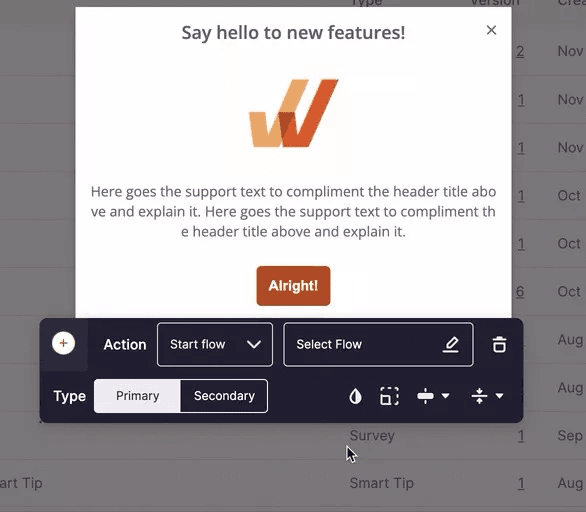
Key features
- In-app guidance: Whatfix lets you use product tours to guide users through your product and features. You can also create task lists, pop-ups, and different UI patterns to walk users through your product or feature adoption process.
- Contextual help: You can insert guidance within a product’s UI to ensure users have access to key information at the right time. For example, you can embed tooltips that expand when users engage with them.
- Self-help: Whatfix’s self-help widgets are usually displayed on the right side of the users’ screens. This way, employees can easily search for product documentation or other resources they need when using an application.
Pricing
Whatfix does not provide fixed public pricing—all tiers are quote-based.
- Average annual spend is around $23,000–24,000 for typical enterprise deals.
- Plans are structured by user context (employee vs customer), and include variations across DAP, Product Analytics, and Mirror products.
- Startups or small SMBs may find entry costs upwards of $1,000/month, making the platform more suited to mid and large enterprises.
6. MoEngage: Best AI-powered in-app messaging solution
MoEngage is a powerful AI-driven customer engagement platform with tools to maximize user engagement.
It empowers marketers with AI-driven insights to create omnichannel customer interactions.
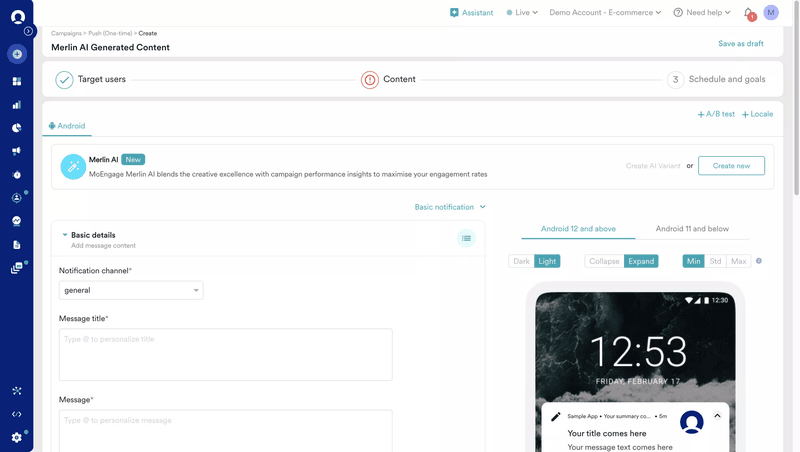
Key features
- Omnichannel messaging campaigns: MoEngage lets you build your messaging campaign using different channels, including in-app messaging and push notifications.
- AI-powered campaign optimization: MoEngage’s AI assistant can help you choose the best content version to present to your customers based on their past behavior. The AI can also help you identify the best time to send messages to your customers to increase the chances of engagement and conversion.
- Website personalization tools: MoEngage has some website personalization tools that can help you create relevant content and ensure a positive user experience.
Pricing
MoEngage has a free Starter plan capped at 10,000 monthly tracked users (MTUs) and two paid plans (Growth and Enterprise) calculated based on your MTUs.
7. Pushwoosh: Best omnichannel communication tool
Pushwoosh is an omnichannel customer engagement tool that drives engagement and enables quick decisions with push notifications.
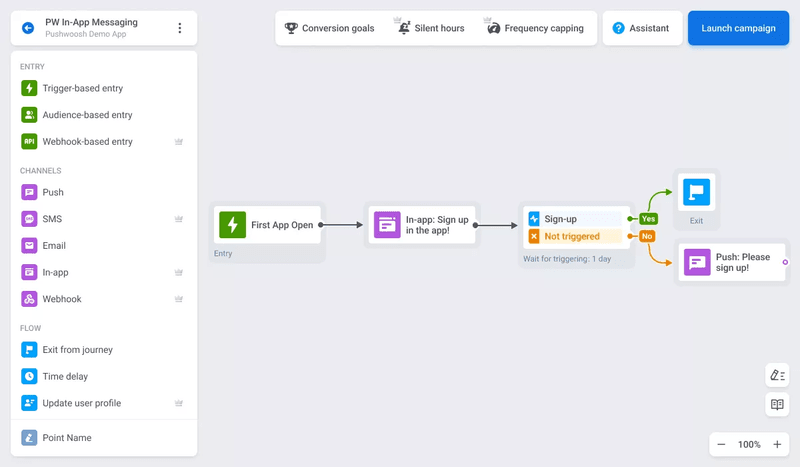
Key features
- No-code in-app messages: Pushwoosh’s in-app messaging allows teams to create in-app notifications without the coding or engineering experience.
- Push notifications: This flagship feature from Pushwoosh allows businesses to send engaging messages to users who aren’t logged into your app or product.
- Customer journey builder: Pushwoosh’s drag-and-drop visual builder lets you map out your customers’ journey and set trigger messages based on their interactions with different touchpoints.
Pricing
Pushwoosh’s pricing starts at $49/month plus an extra $3 per 1,000 subscribers. There is also a custom plan that is available upon request.
8. CometChat: Best for sending audio and video in-app messages
CometChat is an in-app messaging software development kit that empowers app developers to integrate text chat as well as voice and video messaging capabilities into their apps and websites.
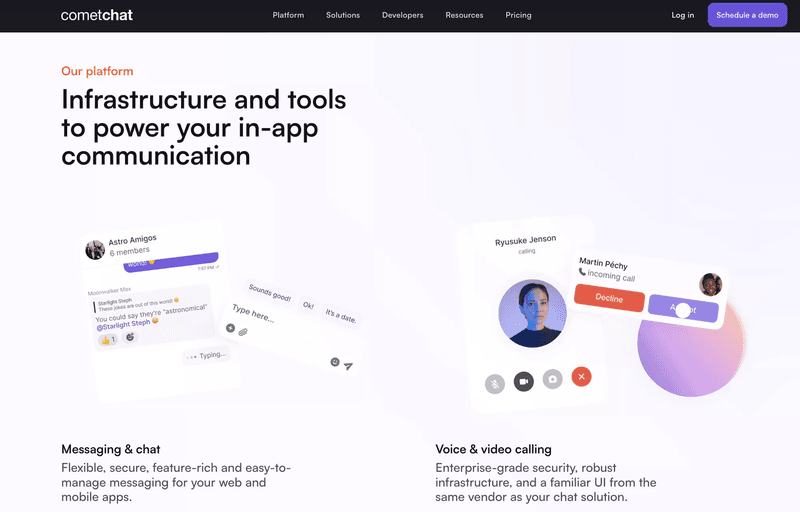
Key features
- Voice and video calling: With CometChat, this feature can be integrated into your app, giving your users a comprehensive communication solution.
- Real-time chat: CometChat’s real-time chat feature allows for instant communication between users while they use your app.
- Collaboration: Users can share files, documents, and screens. This is perfect for brands that require collaboration tools.
Pricing
CometChat’s pricing comprises three tiers:
- Build: This is the free plan. It is free for up to 25 users and the users get access to all Scale plan features. Users can also make up to 1000 voice and video calls for free.
- Growth: Starting at $119/month for the Chat & Messaging feature, this plan includes core messaging and advanced interactions. The plan is pay-as-you-go for the Voice & Video Calling feature.
- Scale: This is custom-priced for businesses with higher needs.
9. Leanplum: Best in-app messaging strategy optimization platform
Leanplum is a mobile marketing platform that helps organizations engage customers through personalized messages.
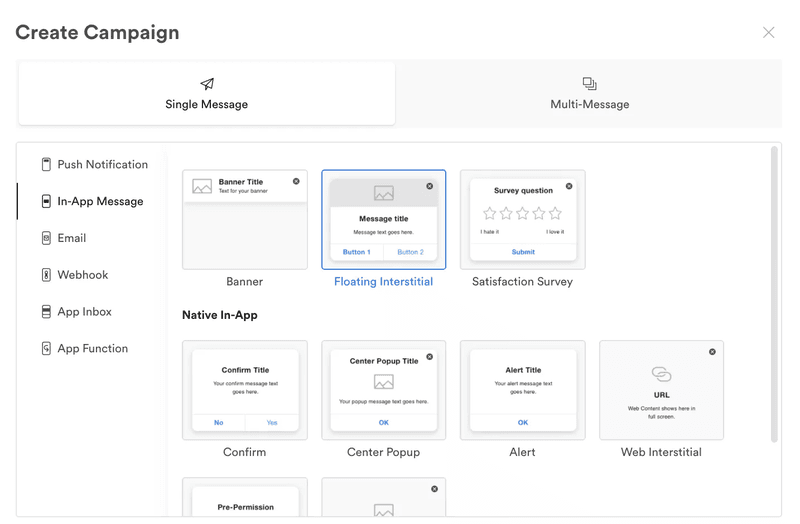
Key features
- A/B testing: Leanplum lets you test multiple message variants to identify the most effective in-app messages.
- Visual segment builder: You can segment customers according to their behavior and craft in-app messages that address their needs.
Pricing
Leanplum is custom-priced based on the users’ needs.
10. Intercom: Best chatbot tool for in-app messaging
It is a comprehensive AI-first solution that gives users instant support and reduces friction.
Intercom’s in-app messaging features include an onboarding checklist, an in-app resource center, and an AI chatbot.
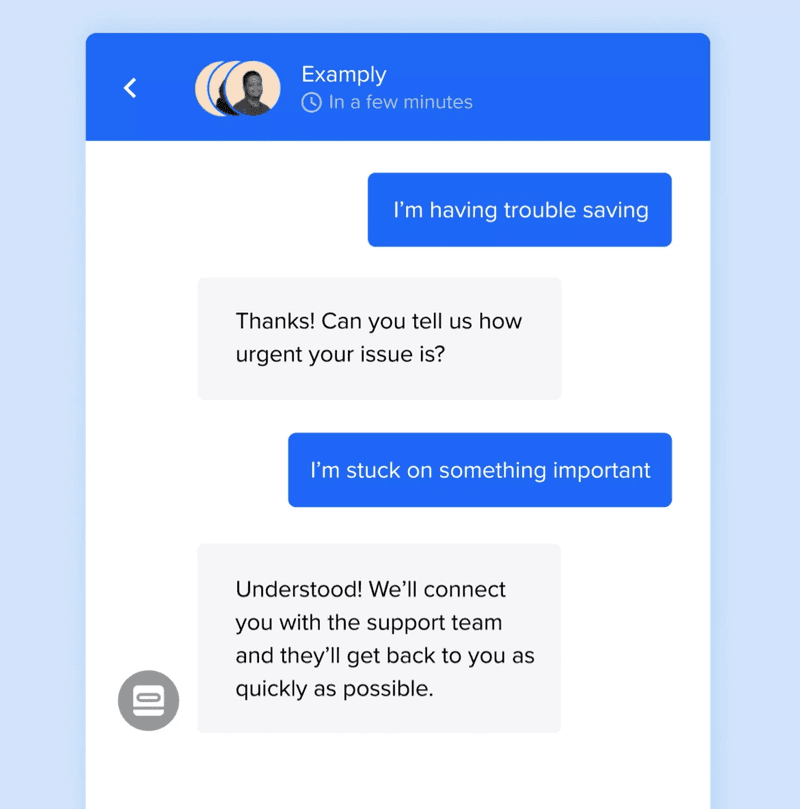
Key features
- Chat widget: Intercom provides users with an in-app chat widget that lets them connect with support agents, send queries to a chatbot, and run searches on the help center. You can also schedule automated messages to users with the widget.
- Automated popups: You can send in-app messages with Intercom’s UI patterns if you install the Product Tours add-on ($199/month). These include tooltips, banners, and announcements.
- Scheduling settings: You can select the days, times, and start dates for your in-app messages with this feature. For example, you can set a stop or start date for an announcement message to advertise an old feature as a new one.
Pricing
Intercom’s entry-level plan pricing starts at $74/month. The Pro tier and higher plans are custom-priced, depending on the user’s needs.
Conclusion
In today’s hyper-connected world, every screen offers you an opportunity to engage with your customers. The correct use of in-app messages can help you drive engagement, boost user retention, and grow your business.
The top in-app messaging tools discussed above will help you develop a powerful marketing strategy. Book a demo today and learn how to implement in-app messaging for maximal success!

